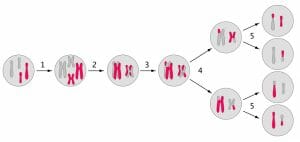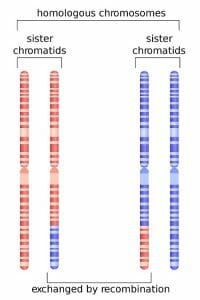Linked Genes Definition
Linked genes are genes that are likely to be inherited together because they are physically close to one another on the same chromosome. During meiosis, chromosomes are recombined, resulting in gene swaps between homologous chromosomes. If genes are close together, the chances of being recombined are higher than if they are far away from each other. It is impossible for linked genes to be on different chromosomes.
Homologous Recombination
Chromosomes are recombined during meiosis. During homologous recombination, the chromosomes can be “cut” at random points after which they are combined with another copy of a homologous chromosome that has been cut at the same point. This way, the DNA from one chromosome ends up in another homologous chromosome. Let’s take a closer look at this.
Chromosomes are DNA strands containing hundreds or even thousands of genes. Most organisms that engage in sexual reproduction have two copies of each chromosome. Whereas both copies of each chromosome have the genes for the same feature (e.g. hair color), each copy of the chromosome may contain a different allele (e.g. one copy may code for black hair and the other copy for red hair). Two chromosomes with the same genes, even if they have different alleles, are called homologous chromosomes.
There is however one type of cells that have only one copy of each chromosome instead of two: gametes (eggs and sperm in the case of humans). To form gametes, cells undergo meiosis, which consists in cell division whereby the daughter cells obtain one copy of each chromosome instead of two. It is during meiosis that homologous recombination occurs.
The following figure shows how homologous recombination occurs during meiosis:
In this figure, the cell on the left originally has two different copies (gray and pink) of two different chromosomes (large and small). Each copy has the same genes as the other copy but is very likely to have different alleles; that is why they are shown in different colors.
The cell then makes an identical copy of each copy (second panel in the figure). There are now two pairs of homologous chromosomes, all of them attached to an identical copy. Each identical copy is also called sister chromatid. There are therefore four pairs of sister chromatids.
In the third panel of the figure, we can see that each pair of sister chromatids gets aligned next to the other pair of sister chromatids, or in other words, homologous chromosomes are aligned. This is the time in which recombination occurs.
Recombination takes place in the fourth panel of the figure: the DNA of two homologous sister chromatids are cut and rejoined. This step is also illustrated and can be seen more clearly here:
One chunk of the DNA has been swapped between homologous chromosomes, resulting in a new combination of alleles. Importantly, the site at which this DNA cut occurs is mostly random. Furthermore, meiosis occurs every time new gametes are formed; therefore, the cut is in a different location along the DNA, leading to numerous possible combinations.
In the next step (fifth panel in the figure), the cell divides into two, with the two daughter cells receiving two copies of each chromosome, each copy carrying different alleles and also the recombined DNA.
In the last step (sixth panel), the two daughter cells divide again without replicating their DNA, leading to four daughter cells, each with one copy of each chromosome. Notice how the recombined DNA makes the daughter cells different from one another.
Recombination of Linked Genes
It is essential to understand homologous recombination to comprehend linked genes. Now that we know that the chromosomes are cut at random places during homologous recombination, we can see how linked genes are inherited together. Let’s take a real example to better understand it: freckles and red hair.
It is very common to find people with freckles and red hair. In fact, this occurs way more often than it would by chance; otherwise, many blonde or brunette people would have freckles more often, and fewer red-haired people would have freckles. This happens because the genes that code for freckles and the genes that code for red hair sit close together on the same chromosome. When homologous recombination occurs, it is very unlikely that the DNA will be cut in between the two genes. Although homologous recombination happens numerous times, these two features are inherited together most of the time because the chances that the DNA coding for these two genes is split up are very low, consequently leading to the genes being inherited together most of the time.
Gene Maps
Scientists have developed ways to figure out where the genes are located based on the frequencies of recombination. This is done by analyzing the offspring of an organism such as fruit flies (Drosophila melanogaster).
If two different genes are on two separate chromosomes, then the offspring will inherit the four alleles (two alleles for each gene) in equal percentages: 25% will inherit allele A of chromosome 1 and allele A of chromosome 2, 25% will inherit allele B of chromosome 1 and allele A of chromosome 2, 25% will inherit allele A of chromosome 1 and allele B of chromosome 2, and 25% will inherit allele B of chromosome 1 and allele B of chromosome 2. The way it is usually calculated is in terms of the alleles shared with the parent organisms. In this case, 50% would inherit the parental genes, and the other 50% would inherit a combination of the parental genes.
If, on the other hand, the two different genes sit on the same chromosome, then the offspring will inherit the four alleles in different percentages. The percentage of offspring inheriting the parental genes will be larger than 50%, whereas the percentage of offspring inheriting a combination of the parental genes will be lower than 50%. If the percentage is lower but still close to the expected 50% of combined parental genes, then the genes are on the same chromosome but far apart, perhaps one on each side of the chromosome so that it is very likely that the DNA in between them will be cut during recombination. If the percentage of the offspring having combined parental genes instead of parental genes is very low, e.g. 4%, then the genes sit very close together on the chromosome.
Quiz
1. What are linked genes?
A. Genes that are related in terms of the phenotype they induce.
B. Genes that are likely to be inherited together.
C. Genes that sit on the same chromosome.
D. B and C.
2. Why are linked genes inherited together?
A. Because they are related.
B. Because they are transcribed simultaneously.
C. Because they sit close together on the same chromosome.
D. Because they are dominant.
References
- Genetic Science Learning Center. (2014, December 2). Genetic Linkage. Retrieved from: http://learn.genetics.utah.edu/content/pigeons/geneticlinkage/
- Lobo, I. & Shaw, K. (2008). Discovery and Types of Genetic Linkage. Nature Education, 1, 1: 139.
Linked Genes
No comments:
Post a Comment